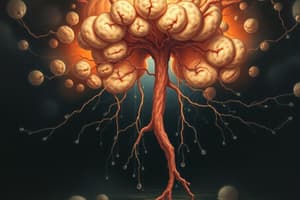Podcast
Questions and Answers
What are meninges?
What are meninges?
- The covering of the brain and spinal cord
- Continuous in the cranial and spinal nerves (correct)
- Layers of the brain
- None of the above
Which layers make up the brain?
Which layers make up the brain?
- Dura Mater
- Arachnoid Mater
- Pia Mater
- All of the above (correct)
What does the Dura Mater contain?
What does the Dura Mater contain?
Dural venous sinuses
What does the Arachnoid Mater contain?
What does the Arachnoid Mater contain?
What is meningitis?
What is meningitis?
What are the symptoms of meningitis?
What are the symptoms of meningitis?
What are the functions of cerebrospinal fluid?
What are the functions of cerebrospinal fluid?
Where is cerebrospinal fluid formed?
Where is cerebrospinal fluid formed?
What is the route of cerebrospinal fluid?
What is the route of cerebrospinal fluid?
How many pairs of cranial nerves are there?
How many pairs of cranial nerves are there?
What does the olfactory nerve (I) control?
What does the olfactory nerve (I) control?
What is the function of the optic nerve (II)?
What is the function of the optic nerve (II)?
What is the role of the oculomotor nerve (III)?
What is the role of the oculomotor nerve (III)?
What does the facial nerve (VII) control?
What does the facial nerve (VII) control?
What does the vagus nerve (X) control?
What does the vagus nerve (X) control?
What is the function of the reticular activating system (RAS)?
What is the function of the reticular activating system (RAS)?
What role does the limbic system play?
What role does the limbic system play?
Flashcards are hidden until you start studying
Study Notes
Meninges and Cerebrospinal Fluid
- Meninges are protective membranes surrounding the brain and spinal cord, continuous across both.
- Three layers of the meninges are Dura Mater, Arachnoid Mater, and Pia Mater.
- Dura Mater contains dural venous sinuses for venous blood drainage.
- Arachnoid Mater includes the subarachnoid space, which houses cerebrospinal fluid (CSF), and arachnoid villi for CSF absorption.
- Meningitis is the inflammation of the meninges, which can be caused by viral or bacterial infections. Symptoms include flu-like signs, stiff neck, potential severe complications like blood clots, and even death.
- Cerebrospinal fluid provides mechanical protection, chemical stability, and aids in nutrient and waste circulation. It is formed by the choroid plexus located in the brain ventricles.
- The route of CSF: lateral ventricles → third ventricle → fourth ventricle → surrounding spinal cord and brain → absorbed by arachnoid villi into dural venous sinuses.
- Hydrocephalus is a condition characterized by an excess of fluid in the brain.
Blood-Brain Barrier
- The blood-brain barrier maintains a stable environment for the brain, formed by capillary walls and astrocytes.
- It features tight junctions between cells, preventing unwanted substances from passing while allowing facilitated diffusion of essential nutrients.
Brain Structure and Functions
- The brain consists of four primary parts: brainstem, cerebellum, diencephalon, and cerebrum.
- Medulla Oblongata contains pyramids (motor impulses) and vital reflex centers for cardiovascular and respiratory functions.
- Olives in the medulla relay muscle stretch and joint information to the cerebellum. Gracile and cuneatus nuclei relay sensory impulses to the somatosensory cortex.
- Pons serve as a bridge for axons connecting left and right cerebellum and carry ascending and descending sensory tracts.
- Midbrain includes the cerebral peduncles (motor and sensory tracts), superior and inferior colliculi for reflexes, and substantia nigra, which releases dopamine to regulate subconscious muscle activities.
Cerebellum and Diencephalon
- The cerebellum is responsible for coordination, balance, and posture, featuring an outer cortex (folia) and internal white matter (arbor vitae).
- Diencephalon includes the thalamus (sensory relay station) and hypothalamus (controls autonomic functions and homeostasis).
Cerebrum and Brain Lobes
- The cerebrum is the largest brain part with two hemispheres divided into five lobes: frontal, temporal, occipital, parietal, and insula.
- The cerebral cortex, composed of unmyelinated neurons, hosts sensory, motor, and association areas, with functions like voluntary control and sensory processing.
- The basal ganglia are responsible for monitoring and regulating movement intensity.
Limbic System
- The limbic system, located in the inner border of the cerebrum and the floor of the diencephalon, plays a significant role in emotions, olfaction, and memory.
Cranial Nerves
- There are 12 pairs of cranial nerves, each with distinct functions:
- I Olfactory: Smell
- II Optic: Vision
- III Oculomotor: Eye movement and pupil constriction
- IV Trochlear: Eye movement
- V Trigeminal: Sensory and motor functions (chewing)
- VI Abducens: Eye movement
- VII Facial: Facial expressions and salivary gland secretions
- VIII Vestibulocochlear: Equilibrium and hearing
- IX Glossopharyngeal: Taste, blood pressure, swallowing, salivation
- X Vagus: Controls thoracic and abdominal organs
- XI Accessory: Swallowing and movements of head and shoulders
- XII Hypoglossal: Tongue movement
- The sensory parts of the trigeminal nerve cover the forehead, upper eyelid, and teeth, while its motor aspect facilitates chewing.
Studying That Suits You
Use AI to generate personalized quizzes and flashcards to suit your learning preferences.




